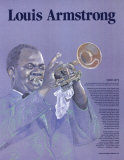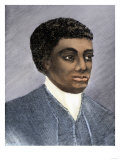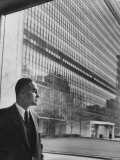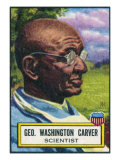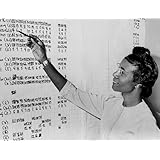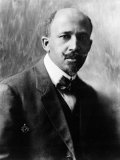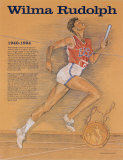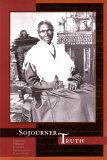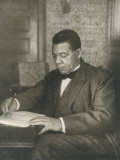|
|
Great Black Americans Poster Series: Black History Posters
for the social studies and language arts classrooms, home schoolers.
|
social studies > history > black history > GREAT BLACK AMERICANS
|
|
The Great Black Americans series of posters celebrate great African American leaders who have made significant contributions in politics, civil rights, sports, the arts, law and science of American society.
Posters include images and bios of Benjamin Banneker, Ralph Bunche, George Washington Carver, Shirley Chisholm, Frederick Douglass, Charles Drew, W. E. B. DuBois, Langston Hughes, Rosa Parks, Sojourner Truth, Harriet Tubman, and Booker T. Washington.
|
|
|
|
|
Benjamin Banneker
b. 11-9-1731; Baltimore Co., MD
d. 10-9-1806
Benjamin Banneker was one of the most remarkable people in American history. He was not able to spend much time in school, yet he became a brilliant scientist. He had a natural gift for surveyor and astronomer. He was a free man in a time when most blacks in America were slaves. But he never took his freedom for granted, and he often attacked slavery as unfair and immoral. Although Benjamin Banneker was one of the best known Americans of his time, many people today know very little about him or his amazing accomplishments.
Benjamin Banneker was born in 1731 in Maryland. At the time, Maryland was a British colony. Benjamin's father was a freed slave who worked as a tobacco farmer. It was on this farm that young Benjamin grew up. But he did not care much for farming. He was more interested in reading and solving math problems. At the age of 21, Benjamin built a working wooden clock after sketching the inside of a pocket watch. In 1771, a family named Ellicott moved near the Banneker farm. George Ellicott became Benjamin's close friend, and taught Benjamin the science of surveying. In 1791, George Washington appointed George Ellicott's cousin Andrew to head up a team of surveyors whose job was to survey a piece of land on the Virginia-Maryland border. This land would become the nation's capital. Andrew chose Benjamin Banneker as one of his assistants. In 1792, Benjamin published his first almanac – a collection of statistics showing the times of sunrise and sunset for every day of the year. The almanac also included such things as the phases of the moon, the movements of stars, and eclipses. Benjamin Banneker made all the calculation himself with his own telescope.
The success of Benjamin's remarkable almanac proved to many people that blacks were just as capapble of scientific thought as whites. Benjamin Banneker became a national celebrity. Even Thomas Jefferson wrote him a letter of congratulations. When Benjamin died in 1806, his death was reported in newspapers across the nation – something that did not often happen to black people at that time. Even today, Benjamin Banneker remains an important example of what people can accomplish if they are given the freedom to follow their dreams.
• more posters and books about Benjamin Banneker
|
|
|
|
|
|
|
|
|
|
Shirley Chisholm
b. 11-30-1924; Brooklyn, NY
d. 1-1-2005
Poster Text: “I'm ‘fighting Shirley Chisholm,’ and I'm unbought and unbossed.” That was how U.S. Representative Shirley Chisholm usually introduced herself to crowds. It was a very good description. Shirley Chisholm has always been a fighter, with very strong opinions and very little patience for people who fought the idea of change. Because of this, she has been called difficult and stubborn. But the many children Shirley Chisholm taught in day care classes, and the many people she helped while she was in Congress know her as a warm and caring person who always took the time to listen to them.
Shirley Chisholm was born in 1924 in Brooklyn, New York. Her parents came to America from Barbados, in the West Indies. Even as a child, Shirley was bossy and independent. Her mother often complained that she could not take her eye off Shirley for a minute. Whe she was still only three, Shirley was sent with her sisters to live with her grandmother in Barbados. This allowed her mother to hold a job, and it gave Shirley the chance to be educated in the strict Barbados schools. In 1934, Shirley and her sisters returned to New York. More than anything else, Shirley loved to read. She read many books by or about famous blacks like Harriet Tubman, W.E.B. DuBois, and Adam Clayton Powell, Jr. In college, Shirley slowly began to grow aware of the unfair treatment of blacks, and this made her both angry and determined to work for change.
This desire soon led Shirley into politics. At first, she worked on the campaigns of other black candidates. At the same time, she worked as a teacher. But in 1964, whe was elected to the New York State Assembly. And in November of 1968, she became the first black woman elected to the U.S. House of Representatives. In Congress, Shirley worked to stop discrimination in housing and employment. And she continued to speak out in favor of equality for women. In 1972, she ran for President as a Democrat and lost. But Shirley always said the real reason she ran was not to win, but to draw attention ito the issues she felt strongly about. Shirley Chisholm has always been a pioneer, and her message is simple: Don't listen to those who say, “you can't.” Listen to the voice inside yourself that says, “I can.” (poster published prior to 2005)
• more posters & books about Shirley Chisholm
|
|
|
|
Frederick Douglass
b. 2-7-1817; Maryland
d. 2-20-1895
Frederick Douglass was one of the most important leaders of the “abolitionist” movement – that is, the movement to end slavery in America. As a runaway slave, he risked his freedom and his life to speak in front of large crowds and tell his story. He told about how he worked from sunrise to well after dark every day, until he fell over from exhaustion. And he told how he had been beaten over and over by his cruel master. One man who listened to him later said: “I think I never hated slavery as much as I did at that moment.”
In 1818, on a farm in Maryland, a boy was born to a slave named Harriet Bailey. Tthe boy, who was named Frederick, knew very little about his father except that he was a white man. Because his mother had to work all day in the fields, young Frederick went to live with his grandmother. But when he was only six years old, he was sent to the plantation to become a slave. The slaves on the farm were treated badly. At dinnertime, a mush made of cornmeal wa dumped in a large tough outside and the children had to spoon it up with oyster shells tied to sticks. All Frederick had to wear was a long shirt that hung to his knees. But he was very bright, and over time he managed to teach himself to read and write. In 1838, he escaped to New York and changed his name to avoid being recaptured.
Soon, Frederick became active in the abolitionist movement. At that time, most abolitionists were white, and blacks had a hard time getting people to listen to them. But Frederick Douglass was such a powerful speaker that he was soon hired by an anti-slavery group to make a lecture tour of the nation. In 1845, he published his autobiograpy, which made him world famous. Throughout his life, Frederick Douglass spoke out on many issues. He called for equal rights for women and for outlawing alcohol. His own sons fought for the Union in the Civil War, helping black slaves win their freedom. When he died in 1895, the whole nation mourned him. Frederick Douglass knew that the road ahead for blacks would be difficult. In one of his last speeches, he noted that many of the rights blacks had won were already being taken away. But as he told his audience, “We still live, and while there is life there is hope.”
• more posters and books
about Frederick Douglass
|
|
|
|
Charles Drew
b. 6-3-1904; Washington, DC
d. 4-1-1950
Poster Text: Charles Drew was a true pioneer. He was the first black person ever to be awarded a Doctor of Science in Medicine degree. He was one of the first black surgeons in America. And he set up the nation's first “blood bank” program. His efforts saved countless lives, and he inspired thousands of young black men and women to enter the field of medicine.
Charles Drew was born into a well-to-do family in Washington, D.C. in 1904. Charles grew up as the oldest of five children, and this helped make him very responsible. His parents taught their children that they should serve the community in some way. Washington was home to many black families, and it was one city where a talented person, on matter what color, could achieve success. And Charles was very talented – both in athletics and in academics. In high school and in college, he starred on the football, track and basketball teams. When a football injury put him in the hospital, Charles watched the doctors with fascination. And after graduating from college, he entered medical school in Canada.
While working as a surgeon at a Montreal hospital, Charles Drew studied the problem of storing blood for transfusions. at that time, blood had to be used right away, or it “spoiled” and became useless. By adding certain chemicals to blood, Dr. Drew found that he could store the blood for about a week. But in 1940, he began to think about using blood plasma instead of whole blood for transfusions. Blood plasma is a clear liquid that contains many of the substances necessary for survival. But it does not contain red blood cells – so it does not “spoil,” and it can be given to any person, no matter what their blood type. Dr. Drew's experiments with plasma were successful. He quickly organized a program to send blood plasma to Europe to help wounded soldiers in World War Two. This effort saved thousand of lives, and made Charles Drew an international hero.
Dr. Drew won numerous awards for his work, and he helped train an entire generation of black medical students. But tragically, just as his career was reaching a peak, he was killed in a car accident. Today he is remembered as a man who dedicated his entire life to teaching and helping others.
• more posters and books about Charles Drew
|
|
|
|
|
|
|
|
|
|
|
|
|
Rosa Parks
b. 2-4-1913; Alabama
d. 10-24-2005; Detroit, MI
Poster Text: Years ago, a young black girl named Rosa McCauley was walking down a street in Montgomery, Alabama. As she passed a white boy on roller skates, the boy gave her a shove. Rosa pushed him back. The boy's mother looked at her angrily and threatened to have Rosa put in jail for pushing her son. Rosa responded that the boy had pushed her, and since she hadn't bothered him, she didn't want to be pushed. Years later, the whole world would discover that Rosa Parks was not someone who could be pushed around.
Rosa McCauly was born in Tuskegee, Alabama, in 1913. Her father was a carpenter and builder, and her mother was a teacher. When Rosa was still very young, she moved with her mother to her grandparent's small farm in Pine Level, Alabama. When she was eleven, Rosa left home to go to school in Montgomery because there were no black junior high schools in her area. Rosa had to leave school in eleventh grade so she could care for her mother and grandmother. Growing up in the South, Rosa lived under segregation – a system that separated blacks and whites and treated blacks as though they were inferior. African-Americans had to go to separate schools, eat in separate restaurants, even drink from separate water fountains. But from an early age, Rosa was taught to be proud of herself and of other black people. In 1932, she married a barber named Raymond Parks. The next year, she got her high school diploma. In 1943, Mrs. Parks joined the local chapter of the National Association for the Advancement of Colored People, or NAACP. In her own quiet way, she began to work for changes in the way blacks were treated in America.
On December 1, 1955, Mrs. Parks left her job as a seamstress and boarded a bus for the long ride home. She walked toward the rear of the bus to find a seat – just as blacks were required to do. The seats up fron were reserved for whites. Soon the bus began to fill up, and suddenly the bus driver was standing over Mrs. Parks ordering her to get up so a white man could have her seat. Mrs. Parks thought for a moment and then said, “No.” The next thing she knew, she was on her way to the police station. Soon the whole city – and then the entire nation – had heard about the brave woman who refused to give up her seat. Rosa Parks became a hero to many African Americans, who decided that it this quiet woman could stand up to prejudice, so could they. In many ways, Rosa Parks's simple act of protest started the whole civil rights movement, which would eventually help African Americans gain many rights. For this reason, she is known today as “The Mother of the Civil Rights Movement.”
• more Rosa Parks posters
|
|
|
|
Wilma Rudolph
b. 6-23-1940; Clarksville, TN
d. 11-12-1994; Brentwood, TN
Poster Text: Wilma Rudolph was born in Tennessee in 1940, the 20th of 22 children. Her parents had to struggle mightily to make ends meet for their large family. Then, at the age of four, Wilma became seriously ill with scarlet fever and pneumonia. The illness left her with a crippled leg, and doctors told here she would never be able to walk normally again. But Wilma refused to give up. She soon recovered completely and grew to be an exceptionally tall and graceful young woman – and in time, she became a star athlete.
Wilma once scored 49 points in a high school basketball game – a school record that still stands! But her greatest triumph came during the 1960 Summer Olympic Games in Rome where she won gold medals in the 100-meter dash, the 200-meter dash, and the 400-meter relay. She set a new Olympic record in the 100 meter-dash with a time of 11 seconds. Wilma Rudolph overcame tremendous odds to become one of the greatest athletes in Olympic history. In 1993, just one year before she died of cancer, she was the first person ever to receive President Clinton's National Sports Awards.
• more women athletes posters
|
|
|
|
Sojourner Truth
b. c 1797; New York State
d. 11-26-1883; Battle Creek, MI
Sojourner Truth was one of the most brilliant speakers in American history. She was born a slave but she refused to let her harsh and lonely childhood break her spirit. She had a deep faith in God, ... to speak out against slavery ... legal right for women ... she became famous all across America for her fiery speeches ...
Around 1797, a young girl was born to two slaves named James and Betsy. They lived and worked on a farm in New York state. The young girl was their ... child, and they named her Isabella. Little did they know at the time, this young .... would someday be as famous as Abraham Lincoln! When Isabella was about 11 years old, her family was split up and......... Isabella decided ... become a traveling preacher. She changed her name to Sojourner Truth, because she ...
• more posters and books about Sojourner Truth.
|
|
|
|
|
|
|
|
|
previous page | top
|
|
I have searched the web for visual, text, and manipulative curriculum support materials - teaching posters, art prints, maps, charts, calendars, books and educational toys featuring famous people, places and events - to help teachers optimize their valuable time and budget.
Browsing the subject areas at NetPosterWorks.com is a learning experience where educators can plan context rich environments while comparing prices, special discounts, framing options and shipping from educational resources.
Thank you for starting your search for inspirational, motivational, and educational posters and learning materials at NetPosterWorks.com. If you need help please contact us.
|
|
|
|










